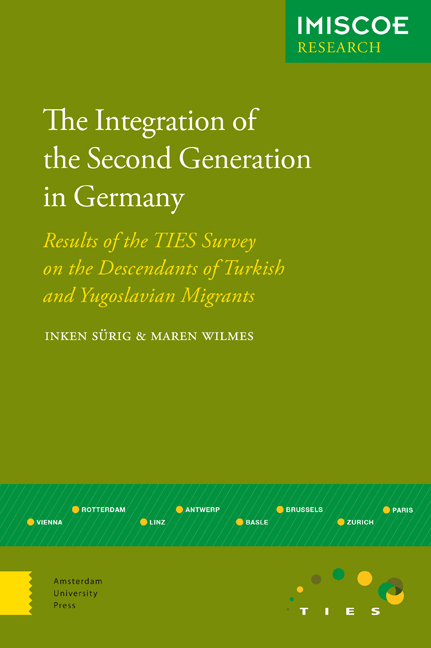 The Integration of the Second Generation in Germany
The Integration of the Second Generation in Germany Book contents
- Frontmatter
- Contents
- Preface: The International Research Project TIES
- 1 Introduction
- 2 Migration History and Basic Demographic Characteristics of the First Generation
- 3 Educational Careers and Educational Outcomes
- 4 Labour Market Positions
- 5 Segregation and Housing
- 6 Ethnic and Cultural Orientations
- 7 Social Relations
- 8 Family Formation and Partner Relationships
- 9 Conclusions and International Comparisons
- References
- Other IMISCOE Research Titles
9 - Conclusions and International Comparisons
Published online by Cambridge University Press: 11 December 2020
- Frontmatter
- Contents
- Preface: The International Research Project TIES
- 1 Introduction
- 2 Migration History and Basic Demographic Characteristics of the First Generation
- 3 Educational Careers and Educational Outcomes
- 4 Labour Market Positions
- 5 Segregation and Housing
- 6 Ethnic and Cultural Orientations
- 7 Social Relations
- 8 Family Formation and Partner Relationships
- 9 Conclusions and International Comparisons
- References
- Other IMISCOE Research Titles
Summary
Empirical access to the second generation of migrants in Germany is still hampered by the lack of official statistics recording both citizenship and migration background. It is only in recent years that research has become more extensive, for instance with the inclusion of migration background in information elicited in the German micro-censuses. Study projects such as TIES also contribute to increased data availability, allowing preliminary analyses of the integration processes of the German-born population of migrant origin.
The TIES questionnaire combines international research perspectives and disciplinary research interests to obtain as thorough a picture as possible of individual integration processes. Interviewing a fixed group of respondents on various aspects of social integration allowed reliable depictions to be created of these processes for the first time. In this context, issues often neglected in statistics were also taken into consideration, such as school transitions in educational biographies and paths from the educational system to the labour market.
This publication is an introductory contribution to the field of study concerned with the integration of the second generation. It has presented a wide-ranging portrait of important areas of integration. Its results are obviously only a first descriptive step in a long list of statistical analyses, many of which are already being pursued by several master's students and doctoral candidates, and which will be published soon.
In the preceding chapters it became clear that the integration of the second generation is a complex process, and that it therefore makes little sense to speak of integration into German society as if there were a single, uniform process of integration into a single, unified society. It can generally be established that, especially with regard to education and the labour market, the distance between second-generation Turks and the control group is greater than for the second-generation Yugoslavs. The former can thus be said to be less successfully integrated into these areas than the latter. At the same time, similar integrative successes and failures are generated under the same conditions. For example, fewer than half of the relevant respondents from all three investigated groups succeeded in proceeding directly to vocational training or higher secondary education after attaining a Hauptschule-leaving certificate.
- Type
- Chapter
- Information
- The Integration of the Second Generation in GermanyResults of the TIES Survey on the Descendants of Turkish and Yugoslavian Migrants, pp. 183 - 188Publisher: Amsterdam University PressPrint publication year: 2015


